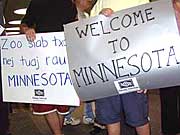| The Hmong in Minnesota |
Medical community readies for Hmong arrival
June 20, 2004
 |
| Dr. Patricia Walker from St. Paul examines a pregnant Hmong woman at the community health clinic at the Hmong refugee camp in Thailand during a visit in March. Walker and a team of medical experts went to the camp to assess the educational, medical and social needs of the refugees before their arrival in Minnesota. (Photo by Paula Bronstein/Getty Images) |
St. Paul, Minn. — Resettlement agencies have been working with several groups to prepare for the Hmong arrival. Many education, health care and government officials have been regularly attending meetings, like one recent event at the International Institute in St. Paul. The challenge they face is figuring out when the bulk of the refugees will actually arrive.
 | |||
The U.S. State Department says it hopes to completely relocate the 15,000 refugees from the camp in Thailand by the end of the year. Over the next six months, they expect about 5,000 refugees to arrive in Minnesota. But they don't know exactly when. Tom Kosel of Catholic Charities summed up the situation last week.
"We are getting a lot of questions from a lot of people as to how many are coming," Kosel said. "How many are living here? How many are going to live there? Where are they going to be? And the answer simply is -- we don't know yet."
Schools and workforce development groups need to know when and where they should increase their classes. Housing is also a concern. But at the top of the list is public health.
Federal law requires that every refugee undergo a health screening within the first three months of their arrival in the United States. The increased caseloads could stretch public health agencies, who have seen budget cuts in recent years.
 | |||
"It will be a challenge," says Ann O'Fallon, refugee health coordinator for the Minnesota Department of Health, "because the numbers coming will be large and the time frame will be small. But I think we can do it."
O'Fallon has been holding regular meetings with clinic providers to discuss the resettlement. She says many local clinics have volunteered to conduct the screenings to help meet demand.
The good news is that public health officials have some idea of the health of the refugees. Mao Thao, Ramsey County's Hmong Health coordinator, visited the camp in March. She says the Hmong in the Wat Tham Krabok camp are living in poor conditions.
"There's no public health infrastructure in the camp. There's open sewers everywhere. People have to pay for their own trash to be picked up," says Thao. "In the last couple of months, since the Thai have found out that these people will be leaving for the U.S., there was trash piling up everywhere."
 | |||
Thao says malnutrition and respiratory infections are predominant in the camp, including tuberculosis. Health officials say 28 refugees have been found to have active tuberculosis, and are now receiving treatment.
Despite those concerns, public health groups say the general health of the camp is better than other refugee camps around the world.
"If I had to rate it -- worse, about the same or better -- I would say it's better," says Dr. Patricia Walker, refugee health coordinator for Regions Hospital in St. Paul. The exception, she says, is mental health issues.
Walker, who visited the camp in March, says initial screenings show 77 percent of the women in the camp showed symptoms of mental health problems, while 32 percent of the men also showed signs of problems.
 | |||
Walker says those problems may be caused in part by the poor living conditions. She says it's possible the depression felt by some of the refugees will go away once they have settled into their new homes.
But it's likely that other mental health problems will continue. Walker says many refugees have lived through the war in Laos, fled their homeland, and are now being relocated once again.
"We will be talking with patients about that, saying, 'When you first come to America you feel safer. You have a roof over your head, and you have food to eat, and have your family with you and you feel happy right now. But a few months from now, you may get a few headaches, stomach pain, more trouble sleeping, and nightmares,'" Walker says.
Walker also says the Thai government is providing a doctor and 15 nurses to work in the camp, after the St. Paul delegation expressed concern over the basic health needs of the refugees. Walker says it will be also important for health care professionals to focus on basic prenatal care and follow-up care, as the refugees begin their lives in the United States.
|
News Headlines
|
Related Subjects
|

